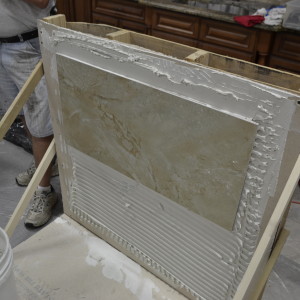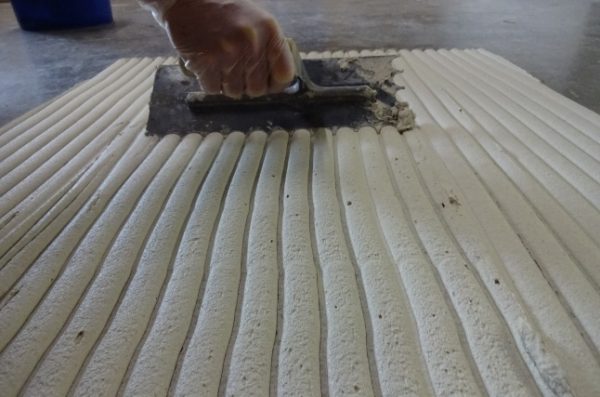An Introduction to Tile Warpage and the Role of Mortar
Posted by TOA's Blog Team on Mar 9th 2017

Tile warpage and mortar? What does that have to do with dreams becoming reality? Plenty if you've been following the product knowledge articles and sessions that take place regularly at Tile Outlets of America.
The two are particularly critical if the tile you've selected is a large format tile.
Trends in Tile: Larger and Longer Sizes!
Tile sizes are definitely trending larger and also longer. As they do, they proportionately have more inherent warpage (where the center of the tile is higher than the edges or ends).
In Managing Lippage: Why Offsets Matter When Installing Tile, we said that,
Minimal warpage is frequent in larger sized tiles; it results from the manufacturing process and should be expected with kiln fired clay products.
As we explained in How To Install Tile Correctly and Get Proper Mortar Coverage,
Another aspect associated with large format tiles that makes mortar coverage critical has to do with the manufacturing process. During the manufacturing process of most large tiles, the center tends to dome or warp upward. This warpage requires more mortar to be used and air is even less likely to be removed when the mortar is swirled (NOTE: be sure to read the original article and watch the video included).
The tile sizes we are referring to have little to do with 8x8 tile installed using a ¼” x ¼” x ¼” trowel. Instead, think 12x24, 10x40 or 6x36 tile planks.
The most effective way of overcoming inherent warpage in large size tile is by having proper mortar coverage, not to mention using the right mortars for large and heavy tile.
What is Allowable Warpage When Installing Tile?
Here's what the Tile Council of North America (TCNA) says about the allowable warpage of a tile:
The ANSI A137.1 standard defined allowed warpage according to the type of tile. For a paver tile (known as Pressed Floor Tile in the Natural category) (commonly used on floors) the allowable warpage is defined as follows:
5.3.1.2.6 Warpage. When measured as described in ASTM C 485, the warpage of each tile in the sample shall not exceed 1.0 percent along any edge nor 0.75 percent on either diagonal.
From this formula the allowable warpage can be determined.
How to Deal with Larger Format Tile with More Inherent Warpage? More and Different Mortar!
An important consideration when you are installing large format tile is having the right kind of mortar for the job and using plenty of it so that it adequately accommodates and supports the high spots in the center of the tile:
- Large and heavy tile, or LHT mortar (formerly known as medium bed mortar)
With that, be sure to check the mortar manufacturer's data sheet or on the back of the bag so you select the appropriate trowel notch size for a ½” mortar thickness after you've placed the tile.
The image below from Do You Have Enough Mortar to Accommodate Most Tile Warpage? shows you how much thicker the configuration for LHT mortar appears compared to conventional thin set mortars.
Note the straight line pattern of the troweled mortar. This is specifically designed to fully support the edges of the tile and the center which, because of tile warpage, will often be higher. The straight trowel lines strengthen the bond between the mortar and the tile.

Properly trowel mortar in straight lines.
Don't Forget to Back-Butter the Tile!
Do you back-butter your large format tile? That's certainly the recommendation we heard in How To Set Large Format Wall and Floor Tile: Merkrete Demonstration.
Back-buttering is the practice of applying a skim coat of mortar on the back of the tile to ensure a good bond to the back of the tile and fill the warped area of the tile as needed. Combine back-buttering with applying enough mortar and you will normally meet or exceed the tile industry minimum standards of 80% mortar coverage on the back of the tile in dry areas and 95% coverage in wet and exterior areas.
Note: all natural stone products require back buttering in every application.
Confirm that the Tile Meets Minimum Mortar Coverage Standards
If you aren't sure you have applied enough mortar, or simply want to verify that your work is up to tile industry standards, regularly check your work. As Do You Have Enough Mortar to Accommodate Most Tile Warpage? recommends,
"The best and most effective way to confirm that this minimum requirement has been met is to occasionally remove a tile. A good tile mechanic meeting the requirements of qualified labor, as recognized by the Tile Council of North America, will use this procedure regularly to ensure that the consumer is getting what they deserve, a high quality, long lasting, and trouble free installation."
Additional Considerations for Tile Warpage and Adequate Mortar
As for any kind of tile installation project - and especially for one with large format tile - you must start with a clean substrate.
Then, you must determine whether it is level enough for your tile installation project. If not, you may need to add a self-leveling product. Do not use mortar or thin set to address issues in the subfloor.
As you install the tile, take into account the proper pattern offsets so as not to create lippage issues. Consider using a leveling system.
>> See Create a Lippage-free Tile Installation with the Tuscan Leveling System
Remember to read the mortar manufacturer's instructions!
What would you add to this introduction to tile warpage and the role of mortar? Let us know in the comments.


